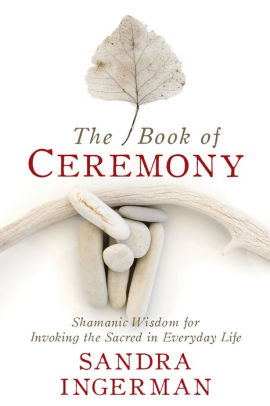The Book of Ceremony is designed to appeal to a broad audience, regardless of religion or spiritual path. These ceremonies are simple enough for beginners to perform but there are also some ceremonies that are more advanced and will be of interest to experienced shamanic practitioners. Ceremonies are for the benefit of communities and therefore typically performed by groups of people. This book will help those who wish to design and perform ceremonies with their own communities. It is not necessary to have prior experience to lead or perform most of these ceremonies. When more advanced knowledge is required, the reader is advised.
Part One lays down the basics: the purpose of ceremony and how to envision and perform it. For shamanic practitioners and pagans who have worked with groups, a lot of this may be familiar as it talks about how to set up, clear the space with herbs, call in the directions, helping spirits and ancestors and set an intention. The guidelines for designing a successful ceremony will help those designing for a group. The final discussion on setting up an Altar in Unseen Realms sets the stage for other shamanic work done in a virtual space rather than together in person.
Part Two focuses on rites of passage and 'Honorable Closure'. Rites of passage include the birth of a child, naming ceremonies, transitioning from childhood, and marriage. Honorable Closure informs us how to step away gracefully from roles and relationships, useful for those who are moving away, breaking up, trying to release the pain of a divorce or moving on respectfully after the death of a loved one.
Part Three has some topics that shamanic practitioners will be more familiar with than the general public such as releasing blocking energies and working with the unseen realms. Readers are given an exercise for feeling the energy in the web of life and guided on how to release blocked energies working with the elements. Work in the unseen realms relies on the previous work of setting up a virtual altar. All participants in a ceremony can be guided in meditation to the virtual altar. Virtual prayer trees are another method for a group to use to focus their prayers. While the concept of doing the work virtually may seem advanced, it functions well with groups who are willing to do guided meditation and may have no prior experience. It is also ideal when people who live far apart wish to work together on an intention. The time of the ceremony or the location of the participants is not important as all join when they can in the virtual space.
Part Four brings the power of ceremony to more areas of life with releasing, blessing and healing people and places. The work of healing buildings, land and bodies of water is not so commonly practiced as the same work with people. These ceremonies for the environment and places for me were the most interesting part of the book. Ingerman discusses that not all changes in the landscape imply a soul loss but can simply be a natural transition. She notes the precautions needed to avoid attracting dis-incarnate souls attached to a place who need healing and further cautions that some of this work should only be done by people who have attained a level of education in shamanic practice sufficient to avoid being harmed by the work of healing. Sometimes it is necessary to do a soul retrieval for the soul of a building or place. Soul retrieval is a more advanced practice and is not within the scope of this book.
Sandra Ingerman has been leading shamanic workshops for decades so she has a wealth of experience working with groups. I found her advice on leading ceremonies for groups of people who may have no interest normally in shamanism nor understanding of it to be of value. For example, she discusses ceremonies that have helped heart attack survivors and natural disaster survivors. Most of the ceremonies will be for people who come together for more personal or spiritual community goals and probably have some notion of what shamanism entails.
The strength of this book is that these ceremonies are flexible enough to please people from a variety of spiritual paths. At times this can make the ceremonies a bit more general than some practitioners may be accustomed to but the design allows for readers to modify to suit their needs. I would especially recommend this book for readers interested in shamanic group work.
Recommended.
~review by Elsie Smyte
Author: Sandra Ingerman
Sounds True
195 pages, $18.95
The Book of Ceremony: Shamanic Wisdom for Invoking the Sacred in Everyday Life

©
2010 - 2025
Facing North
